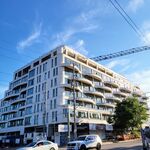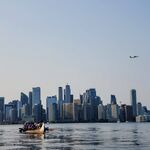human person
New Member
from www.thestar.ca
Regent Park redesign sign of lessons learned
Nov 01, 2007 04:30 AM
Christopher Hume
Nowhere is the power of illusion more clearly demonstrated than at Regent Park.
When the housing complex was designed and constructed in the late 1940s and early '50s, it was seen as the wave of the future, a Utopian project that would satisfy human needs as never before and bring out the best in residents. If only.
Such schemes have proliferated since at least the 19th century, when pioneering urban planner Ebenezer Howard proposed the notion of the Garden City. Hugely influential, the idea called for small towns fully integrated into nature; they were independent communal societies where people would live quietly but happily ever after.
Though there wasn't a shred of evidence to support Howard's views, the world desperately wanted to hear what he had to say. Regent Park was yet another expression of this deep-seated desire to build heaven on earth.
Of course it didn't work. It couldn't. Sadly, this is not how people behave. The concept was so inherently flawed, it's hardly surprising 50-odd years later we are tearing down Regent Park and starting over again. The shared spaces, the isolation from the city, the separation of the neighbourhood from the urban grid – these were well-intentioned but misguided steps.
Half a century later, the result is a place only a drug dealer could love.
True, the slums that were torn down to make way for Regent Park were a civic disgrace, but slums can be rehabilitated. Housing projects can't; they are best demolished.
When the St. Lawrence Neighbourhood was created in the 1970s, the approach was much less idealistic, but much more successful. It was deliberately integrated into the city and the housing, whether full market or geared-to-income, was mixed.
It has not become an area non-residents avoid, where we feel threatened. Despite the generally poor quality of the architecture, it's barely distinguishable from any other neighbourhood in the city.
The current rebuilding of Regent Park incorporates these principles and will undoubtedly be a more desirable place to live. The stigma attached to the area now will disappear in time and in a move that has been unthinkable up to now, middle-class Torontonians will appear. Already stores have decided to move in, again, something that never happened before.
Still the lure of illusion remains irresistible; it's so much more comforting than reality, which has become nasty and downright scary.
And so the question must be asked: Are we making mistakes now that in their turn will make future generations shake their heads and ask, "What were they thinking?"
Or are we growing closer to the truth, to an understanding of how to build communities that work and housing that won't need to be razed?
We're hardly in a position to know; the answers will be revealed over time. But already it's clear that the big issue in the decades ahead will be the remediation not just of 1950s and '60s suburbs such as Rexdale, Flemingdon Park, Malvern and Jane-Finch, but also the sprawling subdivisions of regions beyond.
The illusory nature of these latter communities, based as they are on notions of endless land, cheap gas and the primacy of single-family housing, has started to unravel on the realities of traffic congestion, social dislocation and global warming.
By comparison, the rebuilding of Regent Park will seem straightforward, even simple.
Still, the dream of Garden City will endure long after it has turned into a nightmare.
**********************
I am glad that Regent Park is being redeveloped and the renderings I've seen so far look great. But I've never been convinced that the design of the old Regent Park was a significant factor in its social problems. Lots of residential areas are physically insular, cut off from their surroundings, but that does not make them crime-prone. Indeed isolation can protect an area from crime: if the crime-prone tend to live near the area, and the area itself doesn't contain many crime-prone people.
At the risk of oversimplifying my case, physical insularity doesn't breed crime, people do. I have a hard time believing that Regent Park would have been crime-infested had it been occupied by first-generation Eastern European Jewry and East Asians. I imagine the "insularity" in that case would have been a positive feature of their neighbourhood, making it a cozy ethnic enclave (though parochial as those may be), a refuge from the world beyond.
But it is politically and personally more comforting to put the blame on bricks and street grid rather than on peoples.
Regent Park redesign sign of lessons learned
Nov 01, 2007 04:30 AM
Christopher Hume
Nowhere is the power of illusion more clearly demonstrated than at Regent Park.
When the housing complex was designed and constructed in the late 1940s and early '50s, it was seen as the wave of the future, a Utopian project that would satisfy human needs as never before and bring out the best in residents. If only.
Such schemes have proliferated since at least the 19th century, when pioneering urban planner Ebenezer Howard proposed the notion of the Garden City. Hugely influential, the idea called for small towns fully integrated into nature; they were independent communal societies where people would live quietly but happily ever after.
Though there wasn't a shred of evidence to support Howard's views, the world desperately wanted to hear what he had to say. Regent Park was yet another expression of this deep-seated desire to build heaven on earth.
Of course it didn't work. It couldn't. Sadly, this is not how people behave. The concept was so inherently flawed, it's hardly surprising 50-odd years later we are tearing down Regent Park and starting over again. The shared spaces, the isolation from the city, the separation of the neighbourhood from the urban grid – these were well-intentioned but misguided steps.
Half a century later, the result is a place only a drug dealer could love.
True, the slums that were torn down to make way for Regent Park were a civic disgrace, but slums can be rehabilitated. Housing projects can't; they are best demolished.
When the St. Lawrence Neighbourhood was created in the 1970s, the approach was much less idealistic, but much more successful. It was deliberately integrated into the city and the housing, whether full market or geared-to-income, was mixed.
It has not become an area non-residents avoid, where we feel threatened. Despite the generally poor quality of the architecture, it's barely distinguishable from any other neighbourhood in the city.
The current rebuilding of Regent Park incorporates these principles and will undoubtedly be a more desirable place to live. The stigma attached to the area now will disappear in time and in a move that has been unthinkable up to now, middle-class Torontonians will appear. Already stores have decided to move in, again, something that never happened before.
Still the lure of illusion remains irresistible; it's so much more comforting than reality, which has become nasty and downright scary.
And so the question must be asked: Are we making mistakes now that in their turn will make future generations shake their heads and ask, "What were they thinking?"
Or are we growing closer to the truth, to an understanding of how to build communities that work and housing that won't need to be razed?
We're hardly in a position to know; the answers will be revealed over time. But already it's clear that the big issue in the decades ahead will be the remediation not just of 1950s and '60s suburbs such as Rexdale, Flemingdon Park, Malvern and Jane-Finch, but also the sprawling subdivisions of regions beyond.
The illusory nature of these latter communities, based as they are on notions of endless land, cheap gas and the primacy of single-family housing, has started to unravel on the realities of traffic congestion, social dislocation and global warming.
By comparison, the rebuilding of Regent Park will seem straightforward, even simple.
Still, the dream of Garden City will endure long after it has turned into a nightmare.
**********************
I am glad that Regent Park is being redeveloped and the renderings I've seen so far look great. But I've never been convinced that the design of the old Regent Park was a significant factor in its social problems. Lots of residential areas are physically insular, cut off from their surroundings, but that does not make them crime-prone. Indeed isolation can protect an area from crime: if the crime-prone tend to live near the area, and the area itself doesn't contain many crime-prone people.
At the risk of oversimplifying my case, physical insularity doesn't breed crime, people do. I have a hard time believing that Regent Park would have been crime-infested had it been occupied by first-generation Eastern European Jewry and East Asians. I imagine the "insularity" in that case would have been a positive feature of their neighbourhood, making it a cozy ethnic enclave (though parochial as those may be), a refuge from the world beyond.
But it is politically and personally more comforting to put the blame on bricks and street grid rather than on peoples.




